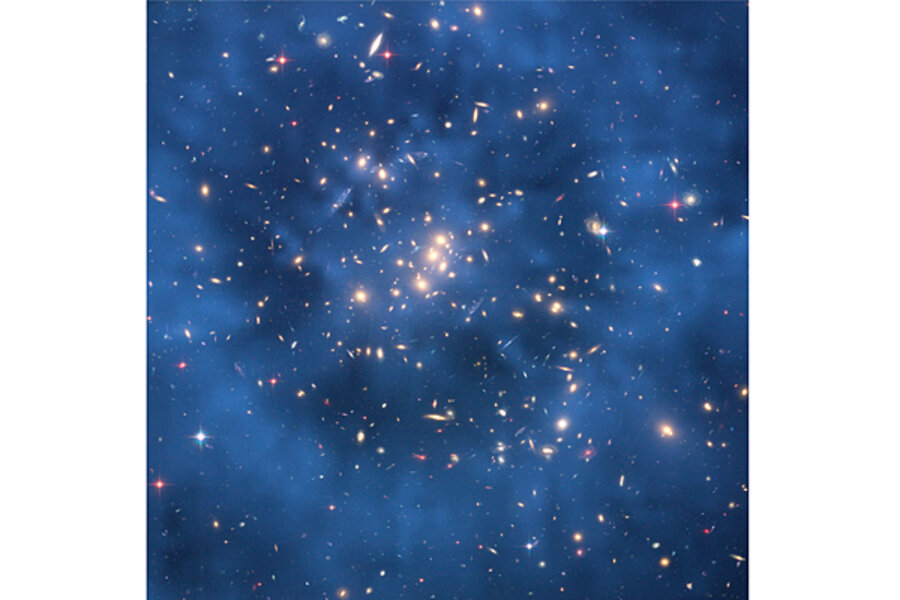Why dark matter may not be so dark after all
Loading...
Physics is the study of matter and energy, so a fundamental question of physics is how much of it there is. But every time physicists try to calculate the amount needed to hold everything together, they always seem to come up short.
And not just by a little bit, either.
Based on observations of how galaxies and clusters of galaxies rotate, how light seems to bend around certain galactic clusters as though they were more massive than they appear, and how the Big Bang's 'afterglow' is distributed throughout the cosmos, scientists have concluded that almost 85 percent of the universe remains unaccounted for.
The most straightforward explanation, say physicists, is that there exists something that makes itself known only indirectly, by tugging on stars and light with its gravitational pull, but that otherwise resists observation.
They call this something "dark matter." According to recent observations, it makes up 26.8 percent of the universe. Another mysterious substance, called "dark energy," thought to make up 68.3 percent of the universe, is believed to be responsible for accelerating the rate at which the universe expands.
The rest is made up of what physicists call "ordinary matter," that is, all the stars, planets, rocks, animals, people, heat, light, radio waves, cosmic rays and everything else that normal people imagine when they hear the word "everything." All that accounts for just 4.9 percent.
Nobody knows what dark matter is made of. The leading candidate is that it is made of WIMPs, or Weakly Interacting Massive Particles, specks of matter left over after the Big Bang that exert a gravitational pull but do not interact in any way with light or other electromagnetic waves.
But scientists have never detected a WIMP for certain. And it's not because they haven't tried. In an attempt to rule out interference from cosmic rays, physicists have gone a half mile underground, in an old iron ore mine in Minnesota. According to the recent measurements, there's a good chance that WIMPs exist. But maybe not.
A new hypothesis proposes a simpler account of all the errant matter. In a paper published online last month by the journal Physics Letters B, Professor Robert Scherrer and post-doctoral fellow Chiu Man Ho, both of Vanderbilt University, suggest that dark matter is made of a theoretical particle called the Majorana fermion.
Named for the Italian physicist Ettore Majorana (who, much like the elusive particles that he studied, mysteriously vanished one day, in 1938), Majorana fermions exhibit a rare form of electromagnetism. Instead of having a "north" and "south" pole, like a bar magnet, the Earth, and almost all ordinary particles, a Majorana fermion, if it exists, would have a doughnut-shaped electromagnetic field called an anapole.
Matter made of particles with dipoles normally have no trouble interacting with electromagnetic radiation. Light usually bounces off of them, for instance. But anapole particles need to be moving quickly before they can be detected. If dark matter, which is thought to be moving much more slowly than it was at the dawn of the universe, is made of Majorana fermions, then that could explain why it's been so hard to spot.
“Most models for dark matter assume that it interacts through exotic forces that we do not encounter in everyday life. Anapole dark matter makes use of ordinary electromagnetism that you learned about in school – the same force that makes magnets stick to your refrigerator or makes a balloon rubbed on your hair stick to the ceiling,” said Dr. Scherrer, in a Vanderbilt news release.
The beauty of Scherrer's and Dr. Ho's hypothesis – in addition to its using fewer hypothetical entities than competing models – is that it can be readily tested. "[T]he model makes very specific predictions about the rate at which it should show up in the vast dark matter detectors that are buried underground all over the world," continues Scherrer. "These predictions show that soon the existence of anapole dark matter should either be discovered or ruled out by these experiments.”
Perhaps that's already happened. A study published in the journal Science in April revealed signatures of Majorana fermions, hiding not in huge galactic clusters, but in tiny crystalline wires.






